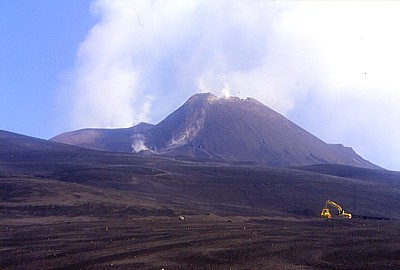|
ETNA IS CURRENTLY FAIRLY QUIET
The latest update is below this line 30
June 2003 update.
The
repose period following the October 2002-January 2003 eruption of
Mount Etna is continuing, with some signs that the central conduit
system is recharging, and movement (slippage) of the unstable eastern
flank of the mountain is continuing. Strong degassing is occurring
at the Northeast Crater, and minor emissions come from the Bocca
Nuova, but none of these seem to be symptomatic of surface eruptive
activity. However, about 23 June there were rumors that some explosive
activity had occurred at the Bocca Nuova, and the obstructed southeastern
pit of this crater was reopening. As a consequence, controls by
Financial Guard and Forest Service staff were tightened in order
to prevent hikers to enter the summit area without an authorized
guide. No further indications of explosive activity were received
thereafter, and during several days of reasonably clear weather
in late June the summit craters were showing their usual degassing
activity without any ash emissions. 20
June 2003 update.
Mount
Etna remains essentially quiet, although deep explosions continue
to be observed in one of the active pits of the Bocca Nuova by visitors
to the summit craters. A visit a fes days ago to the Northeast Crater,
the source of the most intense gas emissions at the summit, by mountain
guide and volcanologist Carmelo Ferlito of the Dipartimento di Scienze
Geologiche at the University of Catania revealed that there was
no noise audible within the active pit of that crater. 11
June 2003 update.
No
new eruptive activity has been observed at Mount Etna over the past
4.5 months, since the end of the major 2002-2003 eruption on 28
January. The volcano is still recovering from its major eruption
that lasted from 26 October 2002 until 28 January 2003, which emitted
some 30 million cubic meters of lava and approximately 50 million
cubic meters of tephra (these figures are very approximate but render
an idea of the "magnitude" of this eruption). It is quite
likely that magma is slowly rising within the central conduit system
(the pathways that lead up to the summit craters). Whether there
is also renewed magma accumulation in the second reservoir that
fed most of the eruptive activity on the southern flank in 2001
and 2002-2003 is uncertain. A summary of the 2002-2003 eruption The 2002-2003 eruption of Mount Etna is featured on numerous web sites. The two principal sources of information (updates, photographs, and other graphic material) are: Charles Rivière's Etna home page, with frequent updates and photos (in French) Like in 2001, Lisetta Giacomelli and Roberto Scandone of the University of Roma 3 have created an incredibly informative and well-illustrated web page, which unfortunately is only available in Italian: Furthermore there are two web cams pointed on the southern flank of Etna, which can be accessed at the web site of: Two further web cams, located at Riposto (east-northeast of Etna) show a wide-angle view and a close-up of the volcano; these are provided by: Alain Melchior presents interesting digital models of the lava flows of the 2002 eruption and has numerous captures from Italian television news of the eruption Eruption 2002 de l'Etna (du 26/10/2002 au ?) One could expect some high-quality photography of the eruption at "Stromboli On-Line", and Marco Fulle's photos do fulfill all expectations... The 2002 eruption of Etna at Stromboli On-Line The same is true for Tom Pfeiffer's photos, which are among the most spectacular of the 2002 eruption so far available - Tom was lucky to be at Etna on the evening of 27 October and photograph the most spectacular phases of activity on the Northeast Rift: This is a relatively poorly known site, created in 2000, which has photos and spectacular video clips of the 2002 eruption (and of the activity in 2000 and 2001 as well): Etna2000.com by Simone Genovese Another web site that has escaped attention thus far, but deserves to be visited (good photos and movie clips, including one of the spectacular explosive eruption at the Voragine on 22 July 1998): Malosito/Geoarchive by Marco Busetta Very spectacular photos of the still-erupting crater at 2750 m elevation on the southern flank (seen from the Torre del Filosofo area) plus a nice map of the upper southern flank of Etna are available on No less spectacular, the view of the eruption from the International Space Station (NASA): The eruption seen from space on 30 October 2002 ...and, of course, there are photos, updates and video clips at Much information (in Italian) is offered by the Catania-based newspaper
| ||||
|
Copyright © Boris Behncke, "Italy's Volcanoes: The Cradle of
Volcanology" | |||||
|
Page set up on 27 May 1997, last modified on 30 June 2003 | |||||

